ENVIRONMENT REPORT
TIDAL POWER IN THE BAY OF FUNDY
Prepared for
Bill Andrson
Professor at St.Lawrence College
for Environmental Science.
INTRODUCTION
The Bay of Fundy, which is found off the shores of Nova Scotia, has the highest tides in the world .
Extraordinary tides occur when the tidal wave length is two to four times the length of the Bay. By virtue of blind luck or physics, the tide is amplified into a standing wave, like water sloshing in a bathtub. For a breaking wave to form, the surging tide must meet an obstacle. When the ocean meets the river going in the opposite direction, the sea hesitates, piles up behind the front line, and advances anew in a tidal bore.
Usually the ingredients occur during a new moon with 15 feet tides and the opposing force of the Shubenacadie river to display the true Bay's magnificence.
This part of St.
John is divided into 3 main areas: the main Harbor, Courtenay Bay and the Outer Harbor. These areas are influenced by the Bay of Fundy tides and the currents of the St John River which flow out of the main Habour into the Bay.
This section also experiences two high and two low tides each day (semi - diurnal), with a tidal range varying from 15 to 18 feet, depending on the type of tides. High - water heights vary from 22 to 28 feet and low - water heights vary from 0 to 7 feet above chart data. Because of these semi - diurnal tides and the action of the St John River, slack water in the Habour occurs at approximately tides and not at high or low water as would be the case at other parts.
THE RHYTHMIC RISE AND FALL
In the Bay of Fundy, the...


